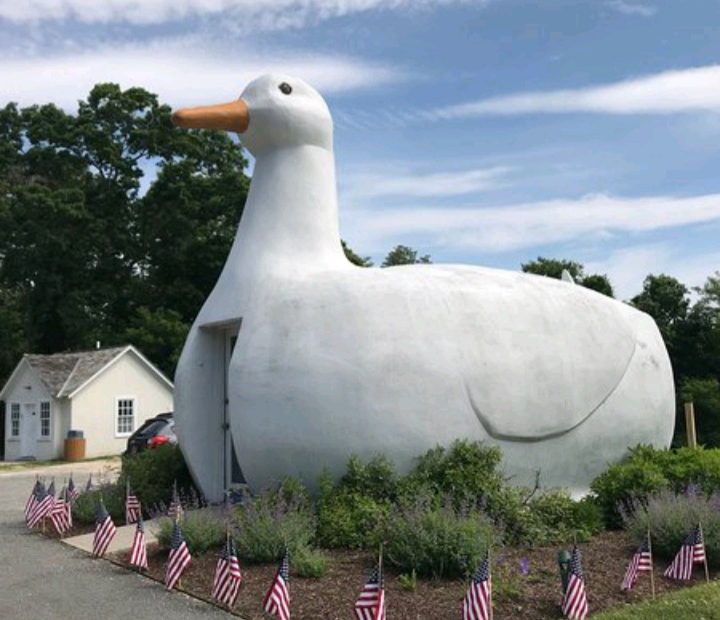

By Titilayo Kupoliyi
At the dawn of the Great Depression, Long Island duck farmer Martin Maurer and his wife, Jeule, were on a road trip and enjoyed a cup of Joe inside a big coffee pot.
They decided, the story goes, that if the world can have a big coffee pot, then it really needs a big duck, and that they would be the ones to provide us all with it.
And so in 1931 was born one of the quirkiest and most influential roadside attractions in American history.
The Big Duck measures 20 feet tall, 18 feet wide, and 30 feet long. It is held together by a wood frame, wire mesh, white stucco cement and 91 years of love, courtesy of countless caretakers and visitors.
The duck’s red eyes come from the tail lights of a Ford Model T.
This was the Great Depression, and it paid to be practical.
To say that the Big Duck remains a popular tourist destination is not to do it justice. A visit to the Big Duck is not just a stop on a vacation itinerary or a side trip during a weekend stay in the Hamptons. Making your way to the Big Duck on Long Island’s East End takes some doing. It is a pilgrimage, something people do because they hear about it and resolve to witness it for themselves.
The Big Duck was made for bucket lists.
That is what a couple and their daughter told ABC’s Localish recently as they took in the splendor of the Big Duck, on Route 24 in Flanders, New York. They had seen it in a book years ago, and now, they were finally seeing it in person.
The Big Duck is a holdover of a time when the East End had dozens of duck farms.
There is only one left today, and it is not the Big Duck. The only ducks you will find being sold from inside its belly these days are of the souvenir variety, but the main draw at the Big Duck has long been the joyful architecture.
Visitors to the Big Duck will likely meet Janice Jay Young, but she is not just ringing up your T-shirt and mug at the cash register. Young has an encyclopedic knowledge about the Big Duck and is one of its proudest promoters. As visitors come in, and they trickle in all day, from far and wide, she is ready with a compressed but compelling history of the Big Duck.
She talks about the Maurer family, who had the pluck to build the duck. She will talk about how this peripatetic Pekin, which first settled in nearby Riverhead, moved a few times over the years, until finally nesting, presumably for good, back in its longtime home of Flanders, at the Big Duck Ranch.
She’ll point to a collage on the wall with dozens of photos, postcards and articles about other examples of programmatic architecture those big coffee pots, big tea kettles, big fish, big ketchup bottles that sprang up across America decades ago, when road trips ruled and plane flights were for the fancy – or were still just flights of fancy.
Richard Martin, director of Historic Services at the Suffolk County Parks Department, explains the term “duck” stuck as a way of describing this kind of architecture – buildings designed to look like the product they sold, hoping to lure motorists off the road to spend a few bucks and maybe snap a picture or two.
As the owner of the duck, Suffolk County is charged with caring for it, with help from Friendslĺ of the Big Duck. The land the duck sits on belongs to the Town of Southampton, and isp0 protected from development. People will be able to visit the duck and the surrounding ranch in perpetuity.
Young said the duck means so much more to locals here in Flanders. In this hamlet, The Big Duck is the center of their community.
“Flanders is kind of a no man’s land. You know, we’re the western part of Southampton Town. And sometimes we just feel a little forgotten here. So there’s no bank, there’s no post office, there’s no Zip Code. You know, we actually have no grocery store,” Young explains.
Flanders does have something nobody else has, she points out.
“We do have a Big Duck.”
Mindat.org
Subscribe to our Telegram and YouTube Channels also join our Whatsapp Update Group